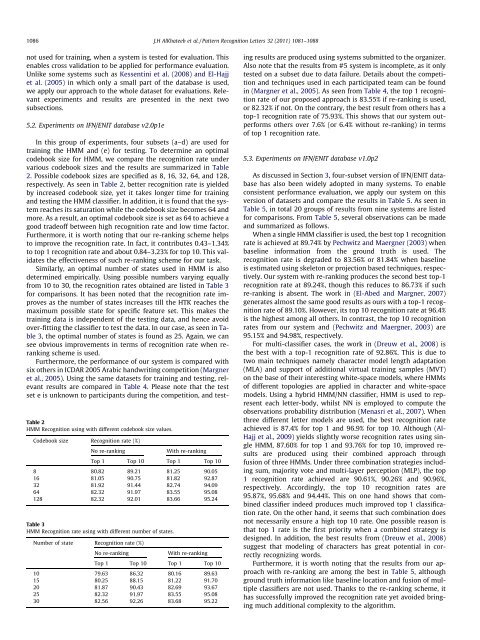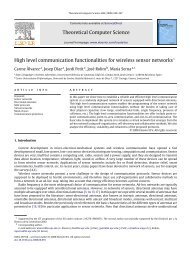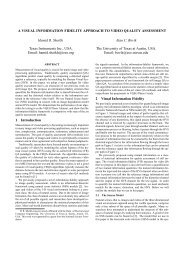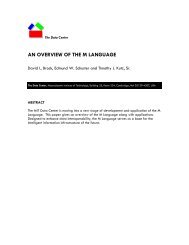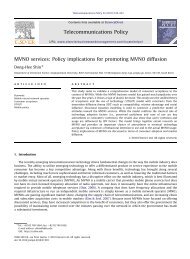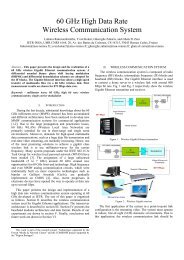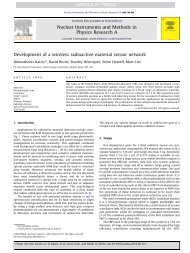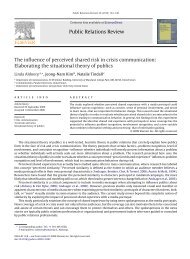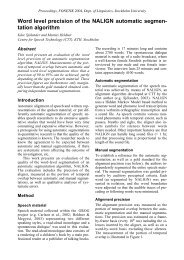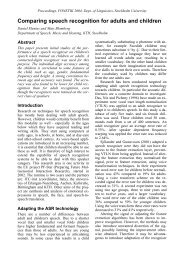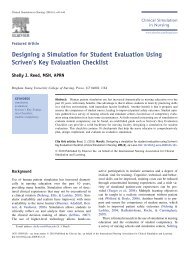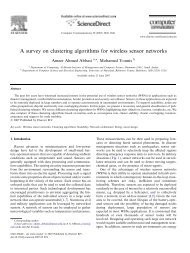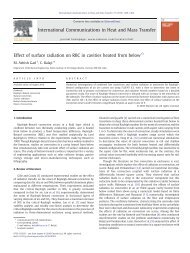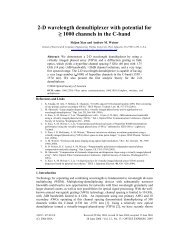Offline handwritten Arabic cursive text recognition using Hidden ...
Offline handwritten Arabic cursive text recognition using Hidden ...
Offline handwritten Arabic cursive text recognition using Hidden ...
You also want an ePaper? Increase the reach of your titles
YUMPU automatically turns print PDFs into web optimized ePapers that Google loves.
1086 J.H AlKhateeb et al. / Pattern Recognition Letters 32 (2011) 1081–1088<br />
not used for training, when a system is tested for evaluation. This<br />
enables cross validation to be applied for performance evaluation.<br />
Unlike some systems such as Kessentini et al. (2008) and El-Hajj<br />
et al. (2005) in which only a small part of the database is used,<br />
we apply our approach to the whole dataset for evaluations. Relevant<br />
experiments and results are presented in the next two<br />
subsections.<br />
5.2. Experiments on IFN/ENIT database v2.0p1e<br />
In this group of experiments, four subsets (a–d) are used for<br />
training the HMM and (e) for testing. To determine an optimal<br />
codebook size for HMM, we compare the <strong>recognition</strong> rate under<br />
various codebook sizes and the results are summarized in Table<br />
2. Possible codebook sizes are specified as 8, 16, 32, 64, and 128,<br />
respectively. As seen in Table 2, better <strong>recognition</strong> rate is yielded<br />
by increased codebook size, yet it takes longer time for training<br />
and testing the HMM classifier. In addition, it is found that the system<br />
reaches its saturation while the codebook size becomes 64 and<br />
more. As a result, an optimal codebook size is set as 64 to achieve a<br />
good tradeoff between high <strong>recognition</strong> rate and low time factor.<br />
Furthermore, it is worth noting that our re-ranking scheme helps<br />
to improve the <strong>recognition</strong> rate. In fact, it contributes 0.43–1.34%<br />
to top 1 <strong>recognition</strong> rate and about 0.84–3.23% for top 10. This validates<br />
the effectiveness of such re-ranking scheme for our task.<br />
Similarly, an optimal number of states used in HMM is also<br />
determined empirically. Using possible numbers varying equally<br />
from 10 to 30, the <strong>recognition</strong> rates obtained are listed in Table 3<br />
for comparisons. It has been noted that the <strong>recognition</strong> rate improves<br />
as the number of states increases till the HTK reaches the<br />
maximum possible state for specific feature set. This makes the<br />
training data is independent of the testing data, and hence avoid<br />
over-fitting the classifier to test the data. In our case, as seen in Table<br />
3, the optimal number of states is found as 25. Again, we can<br />
see obvious improvements in terms of <strong>recognition</strong> rate when reranking<br />
scheme is used.<br />
Furthermore, the performance of our system is compared with<br />
six others in ICDAR 2005 <strong>Arabic</strong> handwriting competition (Margner<br />
et al., 2005). Using the same datasets for training and testing, relevant<br />
results are compared in Table 4. Please note that the test<br />
set e is unknown to participants during the competition, and test-<br />
Table 2<br />
HMM Recognition <strong>using</strong> with different codebook size values.<br />
Codebook size Recognition rate (%)<br />
No re-ranking With re-ranking<br />
Top 1 Top 10 Top 1 Top 10<br />
8 80.82 89.21 81.25 90.05<br />
16 81.05 90.75 81.82 92.87<br />
32 81.92 91.44 82.74 94.09<br />
64 82.32 91.97 83.55 95.08<br />
128 82.32 92.01 83.66 95.24<br />
Table 3<br />
HMM Recognition rate <strong>using</strong> with different number of states.<br />
Number of state Recognition rate (%)<br />
No re-ranking With re-ranking<br />
Top 1 Top 10 Top 1 Top 10<br />
10 79.63 86.32 80.16 89.63<br />
15 80.25 88.15 81.22 91.70<br />
20 81.87 90.43 82.69 93.67<br />
25 82.32 91.97 83.55 95.08<br />
30 82.56 92.26 83.68 95.22<br />
ing results are produced <strong>using</strong> systems submitted to the organizer.<br />
Also note that the results from #5 system is incomplete, as it only<br />
tested on a subset due to data failure. Details about the competition<br />
and techniques used in each participated team can be found<br />
in (Margner et al., 2005). As seen from Table 4, the top 1 <strong>recognition</strong><br />
rate of our proposed approach is 83.55% if re-ranking is used,<br />
or 82.32% if not. On the contrary, the best result from others has a<br />
top-1 <strong>recognition</strong> rate of 75.93%. This shows that our system outperforms<br />
others over 7.6% (or 6.4% without re-ranking) in terms<br />
of top 1 <strong>recognition</strong> rate.<br />
5.3. Experiments on IFN/ENIT database v1.0p2<br />
As discussed in Section 3, four-subset version of IFN/ENIT database<br />
has also been widely adopted in many systems. To enable<br />
consistent performance evaluation, we apply our system on this<br />
version of datasets and compare the results in Table 5. As seen in<br />
Table 5, in total 20 groups of results from nine systems are listed<br />
for comparisons. From Table 5, several observations can be made<br />
and summarized as follows.<br />
When a single HMM classifier is used, the best top 1 <strong>recognition</strong><br />
rate is achieved at 89.74% by Pechwitz and Maergner (2003) when<br />
baseline information from the ground truth is used. The<br />
<strong>recognition</strong> rate is degraded to 83.56% or 81.84% when baseline<br />
is estimated <strong>using</strong> skeleton or projection based techniques, respectively.<br />
Our system with re-ranking produces the second best top-1<br />
<strong>recognition</strong> rate at 89.24%, though this reduces to 86.73% if such<br />
re-ranking is absent. The work in (El-Abed and Margner, 2007)<br />
generates almost the same good results as ours with a top-1 <strong>recognition</strong><br />
rate of 89.10%. However, its top 10 <strong>recognition</strong> rate at 96.4%<br />
is the highest among all others. In contrast, the top 10 <strong>recognition</strong><br />
rates from our system and (Pechwitz and Maergner, 2003) are<br />
95.15% and 94.98%, respectively.<br />
For multi-classifier cases, the work in (Dreuw et al., 2008) is<br />
the best with a top-1 <strong>recognition</strong> rate of 92.86%. This is due to<br />
two main techniques namely character model length adaptation<br />
(MLA) and support of additional virtual training samples (MVT)<br />
on the base of their interesting white-space models, where HMMs<br />
of different topologies are applied in character and white-space<br />
models. Using a hybrid HMM/NN classifier, HMM is used to represent<br />
each letter-body, whilst NN is employed to compute the<br />
observations probability distribution (Menasri et al., 2007). When<br />
three different letter models are used, the best <strong>recognition</strong> rate<br />
achieved is 87.4% for top 1 and 96.9% for top 10. Although (Al-<br />
Hajj et al., 2009) yields slightly worse <strong>recognition</strong> rates <strong>using</strong> single<br />
HMM, 87.60% for top 1 and 93.76% for top 10, improved results<br />
are produced <strong>using</strong> their combined approach through<br />
fusion of three HMMs. Under three combination strategies including<br />
sum, majority vote and multi-layer perception (MLP), the top<br />
1 <strong>recognition</strong> rate achieved are 90.61%, 90.26% and 90.96%,<br />
respectively. Accordingly, the top 10 <strong>recognition</strong> rates are<br />
95.87%, 95.68% and 94.44%. This on one hand shows that combined<br />
classifier indeed produces much improved top 1 classification<br />
rate. On the other hand, it seems that such combination does<br />
not necessarily ensure a high top 10 rate. One possible reason is<br />
that top 1 rate is the first priority when a combined strategy is<br />
designed. In addition, the best results from (Dreuw et al., 2008)<br />
suggest that modeling of characters has great potential in correctly<br />
recognizing words.<br />
Furthermore, it is worth noting that the results from our approach<br />
with re-ranking are among the best in Table 5, although<br />
ground truth information like baseline location and fusion of multiple<br />
classifiers are not used. Thanks to the re-ranking scheme, it<br />
has successfully improved the <strong>recognition</strong> rate yet avoided bringing<br />
much additional complexity to the algorithm.


